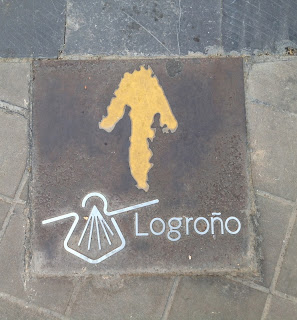 |
| Ed talking with Father Cadarso and his brother as Chamaine looks on. |
We got to the Cathedral by siz-saging through older part of the city.
Father Cadarso lead us into Santiago Cathedral and we walked around admiring the beauty of each section.
 |
| Main Altar |
 |
| Choir Loft |
 |
| Virgin Mary Side altar |
 |
| We blocked our program for the evening. |
Then we waited for everyone to come out so we could continue our City Tour. We would be heading to the more modern side of town. I walked around and saw pictures of the pavement and a fountain with some inscriptions for the pilgrims. I took pictures of two of them as they went to the spring for water. They would then be going into the Cathedral to pay their respect to St James.
I was interested as to why there were so many pilgrims walking the streets of Logrono with their walking sticks and camping back packs on their backs. So I checked this out in James Micheners's book Iberia. He went on a pilgrimage in 1965, and there was little difference as to the purpose and the destination in this modern day.
The pilgrims walk The Way of St. James. They come from all over the world and those in Europe may start in Paris or the Spanish side of the Pyreneese ending in Galacia. The trek through northern Spain begins at Roncesvalles or in Pamplona. Pilgrims continue their trek to Logrono, Santo Domingo de la Calzada, Burgos, Castrogertz, Astorga, Cebrero and finally Santiago de Compostela. They follow the sign of the Shell as seen above in the Logrono sign. Most do the pilgrimage walking though some ride their bikes.
The legend goes that the earliest disciples chosen by Jesus were the brothers James and John. They were the sons of the Galilee fisherman Zebedee and his wife Solome. They were both present at the Crucifiction and shortly after the disciples scattered to different parts of the world proselytizing the new religion. Folk tradition contends that Matthew went to Ethiopia, Thomas to India, Jude to Persia, Simon to Italy, Bartholomew to Armenia, and James went to Spain. There he converted nine Iberians to Christianity. He was rewarded with with the gift: a visit by the Virgin Mary in the city of Zaragoza. (She was still alive at the time.)
James then returned to the Holy Land to energetically propagate the faith throughout the Holy Land. He had exhibited such energy as an apostle that Jesus had given him the nick name, Boanerges, meaning the Son of Thunder. King Herod Agrippa heard he was back in town proselytizing, and he would have nothing of this new religion. So he had James beheaded. Thus, James became the first of the followers of Jesus to attain martyrdom. But the legend does not end there.
The legend continues that after the decapitation in Jerusalem and burial in Caesarea of St. James, his body was mysteriously disinterred and found to have its head once more intact! Into the port of Jaffa came a ship made of stone manned by knights. The body of St James was rescued and sailedt in seven days to the harbor of Iria Flavia on the west coast of Spain in the region of Galicia. The body was taken and buried in a near by old Roman burial site in the year A.D. 44.
Eight hundred years later--*^#!*!^#*-- in 812 a hermit noticed a star hovering over a vacant field. He reported this fact to his religious superiors, and they excavated the field to find the body of St. James whole again and uncorrupted by the passage of time. As a saint descended from heaven (his spirit) and entered the body, St. James assumed personal leadership of the Christian warriors who were battling the superior Muslims who had overrun Spain. At the crucial battle of Clavijo in the year 844, Spanish Christian warriors saw before them St. James riding on a white horse swinging a great sword and killing Moors by the thousands.(This would be great to see in 3D!). From this observation St. James got his Spanish name Santiago Matamoros (killing Moors). Iago is the Spanish word for James and with Saint in front of the name, it morphed into Santiago. It was under the banner of St. James that the Spaniards expelled the Moors, drove out the Jews, and conquered the New World. St. James became the patron saint of Spain.
The symbol of the shell has another legend. One day after the year 812 a bridegroom was riding his horse along the sands by the sea shore to his wedding. Suddenly a large wave swept him and his horse into the sea and he drowned. Upon seeing this his bride appealed to Santiago for help. Miraculously, the groom appeared walking out of the water with his garments covered with white cockleshells. The shells were in the shape of human hands with the ribs extending alms which became the mark of all who fought the infidel and the badge of those who made the pilgrimage to Compostela (the camp of the star).
 |
| A virtual rose garden! |
We then went by a Mall with some ritzy stores and lots of shoe shops. Then we went by a Casino in the making, and finally a Starbucks coffee. If we were not in a hurry to catch the bus to the winery I would have loved to get a Hazelnut Latte with a double pump!
 |
| A modern side of Logrono |








No comments:
Post a Comment